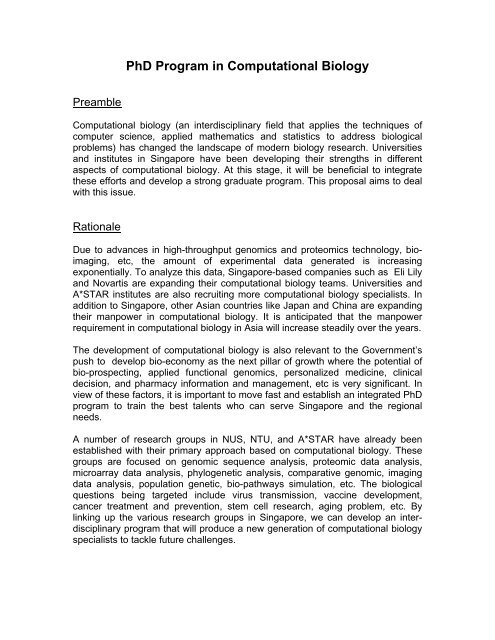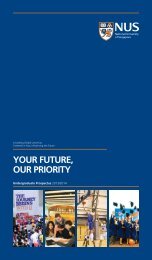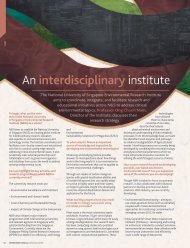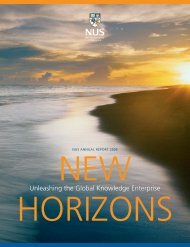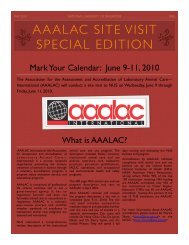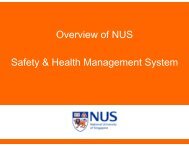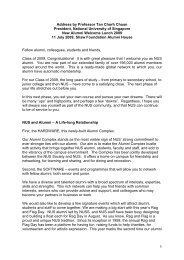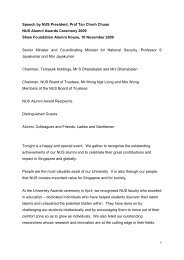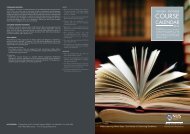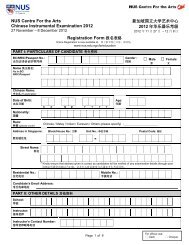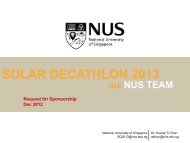PhD Program in Computational Biology
PhD Program in Computational Biology
PhD Program in Computational Biology
Create successful ePaper yourself
Turn your PDF publications into a flip-book with our unique Google optimized e-Paper software.
<strong>PhD</strong> <strong>Program</strong> <strong>in</strong> <strong>Computational</strong> <strong>Biology</strong><br />
Preamble<br />
<strong>Computational</strong> biology (an <strong>in</strong>terdiscipl<strong>in</strong>ary field that applies the techniques of<br />
computer science, applied mathematics and statistics to address biological<br />
problems) has changed the landscape of modern biology research. Universities<br />
and <strong>in</strong>stitutes <strong>in</strong> S<strong>in</strong>gapore have been develop<strong>in</strong>g their strengths <strong>in</strong> different<br />
aspects of computational biology. At this stage, it will be beneficial to <strong>in</strong>tegrate<br />
these efforts and develop a strong graduate program. This proposal aims to deal<br />
with this issue.<br />
Rationale<br />
Due to advances <strong>in</strong> high-throughput genomics and proteomics technology, bioimag<strong>in</strong>g,<br />
etc, the amount of experimental data generated is <strong>in</strong>creas<strong>in</strong>g<br />
exponentially. To analyze this data, S<strong>in</strong>gapore-based companies such as Eli Lily<br />
and Novartis are expand<strong>in</strong>g their computational biology teams. Universities and<br />
A*STAR <strong>in</strong>stitutes are also recruit<strong>in</strong>g more computational biology specialists. In<br />
addition to S<strong>in</strong>gapore, other Asian countries like Japan and Ch<strong>in</strong>a are expand<strong>in</strong>g<br />
their manpower <strong>in</strong> computational biology. It is anticipated that the manpower<br />
requirement <strong>in</strong> computational biology <strong>in</strong> Asia will <strong>in</strong>crease steadily over the years.<br />
The development of computational biology is also relevant to the Government’s<br />
push to develop bio-economy as the next pillar of growth where the potential of<br />
bio-prospect<strong>in</strong>g, applied functional genomics, personalized medic<strong>in</strong>e, cl<strong>in</strong>ical<br />
decision, and pharmacy <strong>in</strong>formation and management, etc is very significant. In<br />
view of these factors, it is important to move fast and establish an <strong>in</strong>tegrated <strong>PhD</strong><br />
program to tra<strong>in</strong> the best talents who can serve S<strong>in</strong>gapore and the regional<br />
needs.<br />
A number of research groups <strong>in</strong> NUS, NTU, and A*STAR have already been<br />
established with their primary approach based on computational biology. These<br />
groups are focused on genomic sequence analysis, proteomic data analysis,<br />
microarray data analysis, phylogenetic analysis, comparative genomic, imag<strong>in</strong>g<br />
data analysis, population genetic, bio-pathways simulation, etc. The biological<br />
questions be<strong>in</strong>g targeted <strong>in</strong>clude virus transmission, vacc<strong>in</strong>e development,<br />
cancer treatment and prevention, stem cell research, ag<strong>in</strong>g problem, etc. By<br />
l<strong>in</strong>k<strong>in</strong>g up the various research groups <strong>in</strong> S<strong>in</strong>gapore, we can develop an <strong>in</strong>terdiscipl<strong>in</strong>ary<br />
program that will produce a new generation of computational biology<br />
specialists to tackle future challenges.
Objectives<br />
<strong>Computational</strong> biology is becom<strong>in</strong>g an important stream <strong>in</strong> biomedical research.<br />
Currently, there is no <strong>PhD</strong> program specializ<strong>in</strong>g <strong>in</strong> computational biology at NUS<br />
or other <strong>in</strong>stitutions. Students need to jo<strong>in</strong> the <strong>PhD</strong> program of either life sciencerelated<br />
or computer science-related departments. As a result, the students<br />
ma<strong>in</strong>ly focus on either the life science or the computer science components.<br />
Thus there is a lack of an <strong>in</strong>tegrated graduate program which comb<strong>in</strong>es the two<br />
components.<br />
Potential participat<strong>in</strong>g Institutions<br />
National University of S<strong>in</strong>gapore<br />
(Coord<strong>in</strong>ator: W<strong>in</strong>g-K<strong>in</strong> Sung)<br />
Duke-NUS Graduate Medical School<br />
(Coord<strong>in</strong>ator: Steve Rozen)<br />
Temasek Life Sciences Laboratory<br />
(Coord<strong>in</strong>ator: Laszlo Orban)<br />
A*STAR, Biopolis<br />
(Coord<strong>in</strong>ator: Vladimir A. Kuznetsov)<br />
Besides the coord<strong>in</strong>ators, there are many <strong>in</strong>vestigators and faculty members who<br />
can be outstand<strong>in</strong>g supervisors and contributors to novel coursework. They<br />
<strong>in</strong>clude:<br />
National University of S<strong>in</strong>gapore:<br />
FoS: Martti Tammi, Chen Yu Zong, Zhang Loux<strong>in</strong>, Christopher Hogue<br />
SoM: Peter Little, Tan T<strong>in</strong> Wee, Fu X<strong>in</strong>-Yuan,<br />
SoC: Wong Lim Soon, P S Thiagarajan, W<strong>in</strong>g-K<strong>in</strong> Sung, David Hsu, Leong<br />
Hon Wai, Anthony Tung<br />
NGS: Tom Fox, Li Baowen<br />
Duke-NUS Graduate Medical School: Steve Rozen<br />
Temasek Life Sciences Laboratory: Jose R. D<strong>in</strong>neny, Greg Jedd, Snezhana<br />
Oliferenko, Laszlo Orban<br />
A*STAR, Biopolis: Dong Yup Lee, Guillaume Bourque, Shyam Prabhakar,<br />
Vladimir A. KUZNETSOV, Frank Eisenhaber, Ng See Kiong, Li Xiaoli, B.<br />
Venkatesh
The postgraduate program<br />
This program is structured to provide a strong and specific foundation for<br />
students to acquire sufficient skills and knowledge to further their research <strong>in</strong><br />
computational biology. S<strong>in</strong>ce a majority of the targeted candidates will be<br />
primarily tra<strong>in</strong>ed <strong>in</strong> either (1) life sciences or (2) comput<strong>in</strong>g/mathematics,<br />
immigration modules <strong>in</strong> both discipl<strong>in</strong>es are <strong>in</strong>corporated to bridge any<br />
deficiencies <strong>in</strong> these students. Then, students will acquire basic skills and<br />
knowledge through the core and foundation modules. For hands-on and more<br />
specific skills, students can acquire them through lab rotations.<br />
In detail, the general structure will be as follows.<br />
1. All students need to identify two supervisors from two different departments or<br />
<strong>in</strong>stitutes. (The ma<strong>in</strong> supervisor should guide the student to identify the<br />
second supervisor.)<br />
2. All students need to take two core computational biology modules (see (A)<br />
below) to acquire sufficient knowledge and skills.<br />
3. All students need to take two modules from the foundation for<br />
comput<strong>in</strong>g/statistics (see (B) below) unless they pass the pre-screen<strong>in</strong>g test<br />
for comput<strong>in</strong>g/statistics.<br />
4. All students are required to do at least one lab rotation (see (D) below). (For<br />
students who do not have evidence that they have wet-lab experience, one of<br />
their lab rotations must have a web-lab component.)<br />
5. Students without basic background <strong>in</strong> biology, comput<strong>in</strong>g, and statistics will<br />
be encouraged to read appropriate immigration modules before beg<strong>in</strong>n<strong>in</strong>g<br />
the core and foundation modules (see (C)).<br />
6. The guidel<strong>in</strong>e for pass<strong>in</strong>g qualifier exam<strong>in</strong>ation and f<strong>in</strong>al defense follows the<br />
NGS standard guidel<strong>in</strong>e.<br />
(A) Core <strong>Computational</strong> <strong>Biology</strong> modules<br />
CS5238 Advanced Comb<strong>in</strong>atorial Methods <strong>in</strong> Bio<strong>in</strong>formatics<br />
CS4220 Knowledge Discovery Methods <strong>in</strong> Bio<strong>in</strong>formatics<br />
CS6280 Special Topics <strong>in</strong> Computer Science on <strong>Computational</strong> Systems<br />
<strong>Biology</strong><br />
CZ5225 <strong>Computational</strong> <strong>Biology</strong>: Model<strong>in</strong>g & Simulation<br />
CZ5226 Advanced Bio<strong>in</strong>formatics<br />
MA5264 <strong>Computational</strong> Molecular <strong>Biology</strong><br />
ST5217 Statistical Methods for Genetic Analysis<br />
(B) Foundation for comput<strong>in</strong>g/statistics<br />
CS5206 Foundation <strong>in</strong> Algorithms<br />
CS5228 Knowledge Discovery <strong>in</strong> Databases<br />
CS5233 Simulation and Modell<strong>in</strong>g Techniques
ST5201 Basic Statistical Theory<br />
PC5202 Advanced Statistical Mechanics<br />
(C) Immigration modules<br />
LS electives:<br />
LCM1101 Biochemistry of Biomolecules<br />
LSM2102 Molecular <strong>Biology</strong><br />
LSM2103 Cell <strong>Biology</strong><br />
LSM2202 Experimental Molecular and Cell <strong>Biology</strong><br />
LSM4241 Functional Genomics<br />
CS/Math electives:<br />
CS1020 Data Structures and Algorithms 1 or CS2020 Data Structures and<br />
Algorithms Accelerated<br />
ST1232 Probability and Statistics<br />
CS2102 Introduction to Database Systems<br />
MA3233 Graph Algorithms<br />
CS3230 Design and Analysis of Algorithms<br />
CS3244 Mach<strong>in</strong>e Learn<strong>in</strong>g<br />
CS3243 Introduction to Artificial Intelligence<br />
<strong>Computational</strong> biology electives:<br />
CS2220 Introduction to Bio<strong>in</strong>formatics<br />
ST2238 Introductory Biostatistics<br />
LSM3241 Bio<strong>in</strong>formatics and Biocomput<strong>in</strong>g<br />
MA3259 Mathematical Methods <strong>in</strong> Genomics<br />
CS4220 Knowledge Discovery methods <strong>in</strong> Bio<strong>in</strong>formatics<br />
ST4243 Statistical Methods for DNA Microarray Analysis<br />
(D) Lab rotation<br />
The aim of lab rotation is to let the students to learn the state-of-the-art concept<br />
and the research skill through hand-on practice. Leverag<strong>in</strong>g on the strengths of<br />
our universities and <strong>in</strong>stitutes, this is one of the important components <strong>in</strong> our<br />
graduate program.<br />
With the help of the supervisor, the student will identify a mentor and participate<br />
<strong>in</strong> the lab for 1 semester. Dur<strong>in</strong>g the semester, the mentor will supervise the<br />
student to f<strong>in</strong>ish a small project. At the end of the lab rotation, the student needs<br />
to write a report. The mentor and one <strong>in</strong>ternal exam<strong>in</strong>er will evaluate the student<br />
and give a grade for the student.
Targeted number of students<br />
Follow<strong>in</strong>g the NGS model, we aim to recruit undergraduate students with good<br />
academic record and potential for research. The student should be a major <strong>in</strong> life<br />
science, mathematics, or comput<strong>in</strong>g. All the short-listed students will be<br />
<strong>in</strong>terviewed.<br />
Number of scholarships offered per year: 10 NGS-type scholarships<br />
Targeted start-date of the program<br />
August 2010<br />
Length of scholarship: 4 year*<br />
* 4 years is regarded as the norm for a <strong>PhD</strong> <strong>in</strong> NUS. Extension can be approved<br />
<strong>in</strong> a case-by-case basis.


